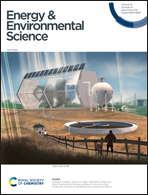High-performance n-type Ta4SiTe4/polyvinylidene fluoride (PVDF)/graphdiyne organic–inorganic flexible thermoelectric composites†
Abstract
In the past decade, the development of high-performance p-type flexible organic–inorganic thermoelectric composites based on nanocarbons (e.g., carbon nanotubes and graphene) has achieved unprecedented success, but progress in the n-type counterpart lags far behind because carbon nanotubes and graphene usually demonstrate p-type behavior. In this work, beyond carbon nanotubes and graphene, we conduct a proof-of-principle study using semiconducting graphdiyne (GDY) to fabricate high-performance n-type organic–inorganic flexible thermoelectric composites. Based on the chemical interactions between GDY and the quasi-one-dimensional semiconductor Ta4SiTe4, we successfully fabricate n-type Ta4SiTe4/polyvinylidene fluoride (PVDF)/GDY composite films. GDY is homogeneously distributed inside the composites, acting as bridges among the Ta4SiTe4 whiskers to significantly improve the electrical conductivity. Combining the well-maintained large Seebeck coefficient and low thermal conductivity, the Ta4SiTe4/PVDF/GDY composite films demonstrate a maximum ZT value of 0.2 at 300 K, among the highest reported in organic–inorganic flexible thermoelectric composites. The protype thermoelectric module that consists of n-type Ta4SiTe4/PVDF/GDY legs and p-type PEDOT:PSS/CNT legs shows the highest normalized maximum power density among the reported organic material-based flexible thermoelectric modules including both n- and p-type legs.



 Please wait while we load your content...
Please wait while we load your content...